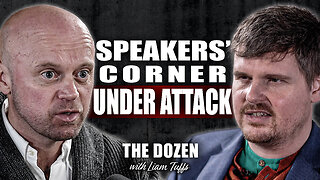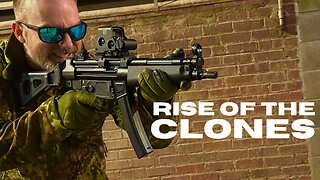Premium Only Content

Investigative Journalism Compilation: Massacres, Terrorism, and Psychological Profiling
Jeffrey MacDonald is a former U.S. Army officer and physician who was convicted of murdering his pregnant wife and two young daughters in their home at Fort Bragg, North Carolina, in February 1970. The case was highly publicized and controversial, with MacDonald maintaining his innocence and claiming that a group of hippies committed the murders.
However, after a lengthy investigation and trial, MacDonald was found guilty of the murders in 1979 and sentenced to life in prison. The evidence presented at trial included physical evidence linking MacDonald to the crime scene, testimony from witnesses who had seen MacDonald with injuries consistent with a struggle, and inconsistencies in MacDonald's own accounts of the events of that night.
MacDonald has continued to appeal his conviction over the years, arguing that the trial was flawed and that new evidence has emerged that supports his innocence. However, his appeals have been unsuccessful, and he remains in prison to this day. The case has been the subject of numerous books, articles, and documentaries, with opinions on MacDonald's guilt or innocence remaining divided.
Menachem Begin was an Israeli politician who served as the Prime Minister of Israel from 1977 to 1983. He was known for his leadership of the right-wing Likud party and his role in the Israeli-Palestinian conflict.
In terms of his psychological profile, Begin was a complex and multifaceted individual. He was known for his strong convictions and his unwavering commitment to his beliefs, which were shaped by his experiences as a survivor of the Holocaust and his deep commitment to Jewish nationalism and Zionism.
Begin was also known for his charisma and his ability to inspire his followers, as well as his strong emotional attachment to his homeland and his people. He was fiercely proud of Israel and its accomplishments, and he saw his role as a leader to be that of a protector and defender of the Jewish state.
At the same time, Begin was also known for his stubbornness and his unwillingness to compromise on certain issues. He was often seen as a polarizing figure, with some admiring his strong leadership and others criticizing him for his hardline stances and his perceived lack of flexibility.
Overall, Begin's psychological profile was that of a passionate and committed leader, driven by a deep sense of purpose and a strong connection to his people and his country. While his leadership style may have been controversial at times, there is no doubt that he played a significant role in shaping Israel's history and its ongoing struggle for security and peace.
The security of US nuclear power plants has been a subject of concern and scrutiny since the 9/11 terrorist attacks. While nuclear power plants are designed to withstand a wide range of threats, including natural disasters and equipment failures, they are still vulnerable to intentional acts of sabotage or terrorism.
Some of the potential vulnerabilities of US nuclear power plants include:
Physical security: While nuclear power plants are heavily guarded and protected by a range of security measures, including armed guards, fences, and surveillance cameras, there is always the risk of a breach. Terrorists could attempt to breach the perimeter of the plant or gain access to sensitive areas by impersonating employees or using other deception tactics.
Cybersecurity: Nuclear power plants are also vulnerable to cyber attacks, which could disrupt the operation of critical systems or even cause a catastrophic failure. Hackers could attempt to gain access to the plant's control systems, either by exploiting vulnerabilities or using social engineering tactics to trick employees into providing access.
Insider threats: Another potential vulnerability is the risk of an insider threat, where an employee or contractor with access to sensitive areas or information could intentionally or unintentionally cause harm. This could include sabotaging critical systems, stealing sensitive information, or providing information to outside actors.
Transportation: Nuclear power plants also face risks from transportation-related incidents, such as attacks on trucks or trains carrying nuclear materials or components.
To mitigate these risks, nuclear power plants have implemented a range of security measures, including increased physical security, enhanced cybersecurity protocols, and improved employee screening and training. However, the potential for a successful attack on a nuclear power plant remains a serious concern, and ongoing efforts are needed to ensure the safety and security of these critical facilities.
Offender profiling, also known as criminal profiling, is an investigative strategy used by law enforcement agencies to identify likely suspects and has been used by investigators to link cases that may have been committed by the same perpetrator.[2] Multiple crimes may be linked to a specific offender and the profile may be used to predict the identified offender's future actions.
History
The first offender profile was assembled by detectives of the Metropolitan Police on the personality of Jack the Ripper,[3] a serial killer who had murdered several prostitutes in the 1880s. Police surgeon Thomas Bond was asked to give his opinion on the extent of the murderer's surgical skill and knowledge.[1] Bond's assessment was based on his own examination of the most extensively mutilated victim and the post mortem notes from the four previous canonical murders.[4] In his notes, dated November 10, 1888, Bond mentioned the sexual nature of the murders coupled with elements of apparent misogyny and rage. Bond also tried to reconstruct the murder and interpret the behavior pattern of the offender.
Theory
Psychological profiling is described as a method of suspect identification which seeks to identify a person's mental, emotional, and personality characteristics based on things done or left at the crime scene.[5]
There are two major assumptions made when it comes to offender profiling: behavioral consistency and homology. Behavior consistency is the idea that an offender's crimes will tend to be similar to one another. Homology is the idea that similar crimes are committed by similar offenders.[6][7][8]
Fundamental assumptions that offender profiling relies upon, such as the homology assumption, have been proven outdated by advances in psychology and behavioral science.[9][10] The majority of profiling approaches assume that behavior is primarily determined by personality, not situational factors, an assumption that psychological research has recognized as a mistake since the 1960s.[11][8]
Profilers have been noted to be very reluctant to participate in studies of profiling's accuracy.[12][13][11][8]
In a 2021 article it was noted that out of 243 cases, around 188 were solved with the help of criminal profiling [8]
Criticism
As of 2021, although the practice of offender profiling is widely used, publicized and researched globally, there is a significant lack of empirical research or evidence to support the validity of psychological profiling in criminal investigations.[14][15] Critics question the reliability, validity, and utility of criminal profiles generally provided in police investigations. Even over the years common criminal profiling methods have changed and been looked down upon due to weak definitions that differentiate the criminal's behaviors, assumptions and their psychodynamic process of the offender actions and characteristics that occur.[citation needed] In other words, this leads to poor and misleading profiles on offenders because they are based on opinions and decisions made up from one profiler conducting research on the offender. Research in 2007-2008 into profiling's effectiveness have prompted researchers to label the practice as pseudoscientific.[13][16] At the time, Malcolm Gladwell of The New Yorker compared profiling to astrology and cold reading.[17] Other critics described criminal profiling as an investigative tool hidden behind a lack of scientific evidence and support.[16]
Unregulated usage
The profession of criminal profiling is highly unregulated.[18] There is no governing body which determines who is and who is not qualified to be a criminal profiler, and therefore those who identify themselves as criminal profilers may range from someone with minimal to someone with extensive experience in the realm of criminal investigation.[18] In addition to the lack of criteria as to what makes an expert in the field of criminal profiling, there is little empirical evidence supporting the accuracy of criminal profiling.[19] There is an abundance of anecdotal support for criminal profiling, much of which originates from reports made by police officers and investigators regarding the performance of criminal profilers.[19] However, law enforcement agents have been found to greatly support the use of criminal profiling, but studies have shown that detectives are poor profilers themselves.[18][19] One study presented police officers with two different profiles for the same perpetrator, each of which varied greatly from the officers’ own description.[20] It was found that the officers were unable to determine whether one profile was more accurate than the other, and felt that all profiles accurately described the perpetrator. Officers were able to find truth in whichever profile they viewed, believing it accurately described the perpetrator, demonstrating the presence of the Barnum effect.[20][21] In addition, an investigator's judgement of the accuracy of a profile is impacted by the perceived source of the information; if the officer believes that the profile was written by an “expert” or “professional”, they are likely to perceive it as more accurate than a profile written by someone who is identified as a consultant.[22] This poses a genuine problem when considering that there are no true criteria which determine who may be considered a “professional” criminal profiler, and when considering that support for criminal profiling is largely based on the opinion of police officers.[18][19]
Typologies
The most routinely used typology in profiling is categorizing crime scenes, and by extension offender's personalities, as either "organized" or "disorganized".[11][17] The idea of classifying crime scenes according to organized/disorganized dichotomy is credited to the FBI profiler Roy Hazelwood.[23]
A typology of serial sexual homicides advocated by Robert Keppel and Richard Walter categorizes them as either power–assertive, power–reassurance, anger–retaliatory, or anger–excitation.[11]
Criminal profiling can also be ex-ante or ex-post. Descriptive profiling of a perpetrator is a type of ex-post profiling, and can be used to prevent a serial killer from striking again.[24]
Approaches
There are three leading approaches in the area of offender profiling: the criminal investigative approach, the clinical practitioner approach, and the scientific statistical approach. The criminal investigative approach is what is used by law enforcement and more specifically by the Behavioral Analysis Unit (BAU) within the FBI. The BAU "assists law enforcement agencies by their review and assessment of a criminal act, by interpreting the offender's behavior during the crime and the interactions between the offender and the victim during the commission of the crime and as expressed in the crime scene."[6] The clinical practitioner approach focuses on looking at each case as unique, making the approach very individualistic. One practitioner, Turco, believed that all violent crimes were a result of the mother-child struggle where female victims represent the offender's mother. This is also recognized as the psychodynamic approach. Another practitioner, Copson, outlined some principles for profiling which include being custom made, interactive and reflexive. By following these principles, the profile should include advice that is unique and not from a stereotype, should be easy to understand for all levels of intelligence, and all elements in the profile should influence one another.[6] The Scientific approach relies heavily on the multivariate analysis of behaviors and any other information from the crime scene that could lead to the offender's characteristics or psychological processes. According to this approach, elements of the profile are developed by comparing the results of the analysis to those of previously caught offenders.[6]
Wilson, Lincon and Kocsis list three main paradigms of profiling: diagnostic evaluation, crime scene analysis, and investigative psychology.[25] Ainsworth[26] identified four: clinical profiling (synonymous with diagnostic evaluation), typological profiling (synonymous with crime scene analysis), investigative psychology, and geographical profiling.[27]
Five steps in profiling include: One- Analyzing the criminal act and comparing it to similar crimes in the past. Two- An in-depth analysis of the actual crime scene, Three- Considering the victim's background and activities for possible motives and connections, Four- Considering other possible motives. Five- Developing a description of the possible offender that can be compared with previous cases.[28]
One type of criminal profiling is referred to as linkage analysis. Gerard N. Labuschagne defines linkage analysis as "a form of behavioral analysis that is used to determine the possibility of a series of crimes as having been committed by one offender."[29] Gathering many aspects of the offender's crime pattern such as modus operandi (MO), ritual or fantasy-based behaviors exhibited, and the signature of the offender, help to establish a basis for a linkage analysis. An offender's modus operandi is the habits or tendencies during the killing of the victim. An offender's signature is the unique similarities in each of the kills. Mainly, linkage analysis is used when physical evidence, such as DNA, cannot be collected.
Labuschagne states that in gathering and incorporating these aspects of the offender's crime pattern, investigators must engage in five assessment procedures: One- Obtaining data from multiple sources. Two- Reviewing the data and identifying significant features of each crime across the series. Three- Classifying the significant features as either modus operandi or ritualistic. Four- Comparing the combination of modus operandi and ritual or fantasy-based features across the series to determine if a signature exists. Five- Compiling a written report highlighting the findings.[29]
FBI method
Main article: FBI method of profiling
There are six stages to developing a criminal profile: profiling inputs, decision process models, crime assessment, criminal profiling, investigation, and apprehension.[6] The FBI and BAU tend to study specific categories of crimes such as white collar and serial murder.[30]
History
An Italian psychologist Cesare Lombroso (1835-1909) was a criminologist who attempted to formally classify criminals based on age, gender, physical characteristics, education, and geographic region. When comparing these similar characteristics, he better understood the origin of motivation of criminal behavior, and in 1876, he published the book The Criminal Man. Lombroso studied 383 Italian inmates. Based on his studies, he suggested that there were three types of criminals. There were born criminals, who were degenerates and insane criminals, who suffered from a mental illness. Also, he studied and found specific physical characteristics. A few examples included asymmetry of the face, eye defects and peculiarities, and ears of unusual size, etc.[31]
One of the first offender profiles was assembled by detectives of the Metropolitan Police on the personality of Jack the Ripper,[32] a serial killer who had murdered a series of prostitutes in the 1880s. Police surgeon Thomas Bond was asked to give his opinion on the extent of the murderer's surgical skill and knowledge.[1] Bond's assessment was based on his own examination of the most extensively mutilated victim and the post mortem notes from the four previous canonical murders.[4] In his notes, dated November 10, 1888, Bond mentioned the sexual nature of the murders coupled with elements of apparent misogyny and rage. Bond also tried to reconstruct the murder and interpret the behavior pattern of the offender.[4] Bond's basic profile included that "The murderer must have been a man of physical strength and great coolness and daring... subject to periodic attacks of homicidal and erotic mania. The characters of the mutilations indicate that the man may be in a condition sexually, that may be called Satyriasis."[33]
In 1912, a psychologist in Lackawanna, New York delivered a lecture in which he analyzed the unknown murderer of a local boy named Joey Joseph, dubbed "The Postcard Killer" in the press.[34]
In 1932, Dr. Dudley Schoenfeld gave the authorities his predictions about the personality of the kidnapper of the Lindbergh baby.[35]: 229
In 1943, Walter C. Langer developed a profile of Adolf Hitler that hypothesized the Nazi dictator's response to various scenarios, including losing the war. The United States Office of Strategic Services asked William L. Langer's brother Walter C. Langer, a psychiatrist, to draw up a profile of Adolf Hitler and hypothesize their response to various scenarios including losing the World War II.[36] After the World War II, British psychologist Lionel Haward, while working for the Royal Air Force police, drew up a list of characteristics which high-ranking war criminals might display. These characteristics were used to identify high-ranking war criminals amongst captured soldiers and airmen.
Offender profiling was first introduced to the FBI in the 1960s, when several classes were taught to the American Society of crime lab directors. There was little public knowledge of offender profiling until publicization with TV. Later films based on the fictional works of author Thomas Harris that caught the public eye as a profession in particular Manhunter (1986) and Silence of the Lambs (1991). The fastest development occurred when the FBI opened its training academy, the Behavioral Analysis Unit, in Quantico, Virginia. It led to the establishment of the National Center for the Analysis of Violent Crime[37] and the Violent Criminal Apprehension Program.
James Brussel was a psychiatrist who rose to fame after his profile of New York City's "Mad Bomber" George Metesky was published in the New York Times in 1956.[38] The media dubbed him "The Sherlock Holmes of the Couch."[39] In his 1968 book Casebook of a Crime Psychiatrist, Brussel relates how he predicted that the bomber would wear a buttoned-up double-breasted suit, but edited out the many incorrect predictions he had made in his profile, claiming he had successfully predicted the bomber would be a Slav who lived in Connecticut, when he had actually predicted he would be "born and educated in Germany," and live in White Plains, New York.[17][40] In 1964, Brussel profiled the Boston Strangler for the Boston Police Department.[36]
In 1972, after the death of J. Edgar Hoover, who was skeptical of psychiatry,[35]: 230–231 the Behavioral Science Unit of the FBI was formed by Patrick Mullany and Howard Teten.[41]
Investigations of serial killers Ted Bundy and the Green River Killer were performed in 1974 by Robert Keppel and psychologist Richard Walter. They went on to develop the four subtypes of violent crime and the Hunter Integrated Telemetry System (HITS) database which compiled characteristics of violent crime for research.[42]
At the FBI's BSU, Robert Ressler and John Douglas began an informal series of ad hoc interviews with 36 convicts starting in early 1978.[35]: 230–231 [43][36] Douglas and Ressler later created a typology of sexually motivated violent offenders and formed the National Center for the Analysis of Violent Crime.[44]
The March 1980 issue of the FBI Law Enforcement Bulletin invited local police to request profiles from the FBI.[43] An article in the April 1980 issue, "The Lust Murderer," introduced the dichotomy of "organized" and "disorganized" offenders.[43] The August 1985 issue described a third, "mixed" category.[43]
In 1985, Dr. David Canter in the United Kingdom profiled "Railway Rapists" John Duffy and David Mulcahy.[36] David Canter assisted police detectives from the mid-1980s to an offender who had carried out a series of serious attacks, but Canter saw the limitations of offender profiling – in particular, the subjective, personal opinion of a psychologist. He and a colleague coined the term investigative psychology and began trying to approach the subject from what they saw as a more scientific point of view.[45]
The Crime Classification Manual was published in 1992, and introduced the term "criminal investigative analysis."[43]
In 1999, The percentage of accurate criminal profilers was only estimated to be at 21%,[42] whereas in 2020 the accuracy was estimated to be at 86%.[citation needed]
Popularity
Profiling has continuously gotten more accurate throughout the years. In the year 2008, only 42% of cases were solved using criminal profiling. In 2019 the FBI was able to solve 56% of the cases that were not solved back in the year 2008. [13]
Profiling as an investigative tool has a high level of acceptance among both the general public and police.[9]
In the United States, between 1971 and 1981, the FBI had only profiled cases on 192 occasions. By 1986, FBI profilers were requested in 600 investigations in a single year. By 1996, 12 FBI profilers were applying profiling to approximately 1,000 cases per year.[11]
In the United Kingdom, 29 profilers provided 242 instances of profiling advice between 1981 and 1994, its usage increasing steadily over that period.[11]
The usage of profiling has been documented in Sweden, Finland, New Zealand, South Africa, Germany, Canada, Ireland, Malaysia, Russia, Zimbabwe, and the Netherlands.[12][11]
Surveys of police officers in the United States, the United Kingdom, and Canada have found an overwhelming majority consider profiling to be useful.[12] A 2007 meta-analysis of existing research into offender profiling noted that there was "a notable incongruity between [profiling's] lack of empirical foundation and the degree of support for the field."[13]
Profiling's continued popularity has been speculatively attributed to broad use of anecdotes and testimonials, a focus on correct predictions over the number of incorrect ones, ambiguous profiles benefiting from the Barnum effect, and the popular appeal of the fantasy of a sleuth with deductive powers like Hercule Poirot and Sherlock Holmes.[11]
Notable profilers
Notable profilers include Roy Hazelwood, who profiled sexual predators; Ernst Gennat, a German criminologist, who developed an early profiling scheme for the police of Berlin; Walter Charles Langer, who predicted Hitler's behavior and eventual suicide; Howard Teten, who worked on the case of Martin Luther King Jr.'s assassination; and John E. Douglas, who worked on a wave of child murders in Atlanta in the 1980s.[46]
According to the BAU the probability of a profiler being used as "expert testimony" in court and leading to a guilty verdict is 85%. There is a difference between the hard sciences and the social sciences related to testimony and evidence in the courtroom. Some experts contend that offender profiling should not be used in court until such processes can be reliably validated, but as seen, it is still used successfully to this day. The historical roots of criminal profiling in the United States and Europe have been discussed elsewhere (1). Many European countries have now developed their own approaches to criminal profiling and established specialized academic research institutions and trained police units (1,6), for example, the German Bundeskriminalamt (7,8), implementing the first quality standards in 2003 (9,10), as well as Austria (11), Scandinavia (12), and the United Kingdom (13). Switzerland has only recently adopted ViCLAS, the computerized Violent Crime Linkage Analysis System, and is now training its own case analysis specialists (1,14,15)
Research
Question book-new.svg
This section relies excessively on references to primary sources. Please improve this section by adding secondary or tertiary sources. (May 2022) (Learn how and when to remove this template message)
In a review of the literature by Eastwood et al. (2006),[12] one of the studies noted, Pinizzotto and Finkel (1990),[47] showed that trained criminal profilers did not do any better than non-profilers in producing an accurate profile. A 2000 study also showed that profilers were not significantly better at creating a profile than any other participating groups.[48]
A survey of statements made in offender profiles done for major cases from 1992 to 2001 found that "72% included repetition of the details of what occurred in the offence (factual statements already known by the police), references to the profiler’s competence [...] or caveats about using the material in the investigation." Over 80% of the remaining statements, which made claims about the offender's characteristics, gave no justification for their conclusion.[49][17]
A 2003 study which asked two different groups of police to rate how accurately a profile matched a description of the apprehended offender, with one group given a description of a completely fabricated offender instead of the real one, found that the profile was rated equally accurate in both cases.[49][17]
There is a lack of clear, quantifiable evidence of a link between crime scene actions (A) and offender characteristics (C), a necessary supposition of the A to C paradigm proposed by Canter (1995).[50][51] A 2002 review by Alison et al. concluded, "The notion that particular configurations of demographic features can be predicted from an assessment of particular configurations of specific behaviors occurring in short-term, highly traumatic situations seems an overly ambitious and unlikely possibility. Thus, until such inferential processes can be reliably verified, such claims should be treated with great caution in investigations and should be entirely excluded from consideration in court."[10]
See also
Crime portaliconLaw portalPsychology portal
Criminology
Forensic profiling
Forensic psychology
Presumption of guilt
Racial profiling
Residential Burglary Expert System
Statistical correlations of criminal activity
References
Skinner, Keith; Evans, Stewart (2013). The Ultimate Jack the Ripper Sourcebook. Little, Brown Book Group. ISBN 978-1472107855.
Woodhams, Jessica; Toye, Kirsty (February 2007). "An empirical test of the assumptions of case linkage and offender profiling with serial commercial robberies". Psychology, Public Policy, and Law. 13 (1): 59–85. doi:10.1037/1076-8971.13.1.59.
psychologytoday.com
Evans, Stewart P.; Skinner, Keith (2013-07-01). Jack the Ripper: Letters from Hell. The History Press. ISBN 9780750953818.
Berg, B. L. (2008). Criminal investigation. Boston: McGraw-Hill Higher Education. ISBN 978-0073401249.
Vettor, Shannon; Woodhams, Jessica; Beech, Anthony (2013). "Offender profiling: A review and critique of the approaches and major assumption". Journal of Current Issues in Crime, Law and Law Enforcement. 6 (4): 353–387.
Goodwill, Alasdair M.; Lehmann, Robert J. B.; Beauregard, Eric; Andrei, Andreea (2014-10-01). "An action phase approach to offender profiling". Legal and Criminological Psychology. 21 (2): 229–250. doi:10.1111/lcrp.12069. ISSN 2044-8333.
Chifflet, Pascale (2014). "Questioning the validity of criminal profiling: an evidence-based approach". Australian & New Zealand Journal of Criminology. 48 (2): 238–255. doi:10.1177/0004865814530732. ISSN 0004-8658. S2CID 145585868.
Jackson, Craig; Wilson, David; Rana, Baljit Kaur (2011). "The usefulness of criminal profiling". Criminal Justice Matters. 84 (1): 6–7. doi:10.1080/09627251.2011.576014. ISSN 0962-7251.
Alison, Laurence; Bennell, Craig; Mokros, Andreas; Ormerod, David (March 2002). "The personality paradox in offender profiling: A theoretical review of the processes involved in deriving background characteristics from crime scene actions" (PDF). Psychology, Public Policy, and Law. 8 (1): 115–135. doi:10.1037/1076-8971.8.1.115. S2CID 55905695. Archived from the original (PDF) on 2021-02-10.
Snook, Brent; Cullen, Richard M.; Bennell, Craig; Taylor, Paul J.; Gendreau, Paul (2008). "The Criminal Profiling Illusion" (PDF). Criminal Justice and Behavior. 35 (10): 1257–1276. doi:10.1177/0093854808321528. ISSN 0093-8548. S2CID 55872956.
Eastwood, Joseph; Cullen, Richard M; Kavanagh, Jennifer; Snook, Brent (2006). "A review of the validity of criminal profiling" (PDF). Canadian Journal of Police and Security Services. 4: 118–124. Archived from the original (PDF) on 2017-10-25. Retrieved 2018-03-04.
Snook, Brent; Eastwood, Joseph; Gendreau, Paul; Goggin, Claire; Cullen, Richard M. (2007). "Taking Stock of Criminal Profiling" (PDF). Criminal Justice and Behavior. 34 (4): 437–453. doi:10.1177/0093854806296925. ISSN 0093-8548. S2CID 17166514. Archived from the original (PDF) on 2019-02-19.
Fox, Bryanna; Farrington, David P. (December 2018). "What have we learned from offender profiling? A systematic review and meta-analysis of 40 years of research". Psychological Bulletin. 144 (12): 1247–1274. doi:10.1037/bul0000170. ISSN 1939-1455. PMID 30475018. S2CID 53746560.
Ribeiro, Rita Alexandra Brilha; Soeiro, Cristina Branca Bento de Matos (January 2021). "Analysing criminal profiling validity: Underlying problems and future directions". International Journal of Law and Psychiatry. 74: 101670. doi:10.1016/j.ijlp.2020.101670. ISSN 0160-2527. PMID 33341721. S2CID 229343858.
Snook, Brent; Cullen, Richard M.; Bennell, Craig; Taylor, Paul J.; Gendreau, Paul (October 2008). "The Criminal Profiling Illusion" (PDF). Criminal Justice and Behavior. 35 (10): 1257–1276. doi:10.1177/0093854808321528. ISSN 0093-8548. S2CID 55872956.
Gladwell, Malcolm (November 12, 2007). "Dangerous Minds". The New Yorker. Retrieved December 7, 2015.
Snook, Brent; Gendreau, Paul; Bennell, Craig; Taylor, Paul (2008). "Criminal Profiling". Skeptic. 14: 42–47, 80.
Kocsis, Richard N. (June 2004). "Psychological Profiling of Serial Arson Offenses an Assessment of Skills and Accuracy". Criminal Justice and Behavior. 31 (3): 341–361. doi:10.1177/0093854803262586. ISSN 0093-8548. S2CID 146215192.
Smith, M., & Alison, L. (2001, March). Barnum effects in offender profiles. Paper presented at the Fifth Biannual Conference of Investigative Psychology, University of Liverpool, Liverpool, UK
Kocsis, Richard N. (April 2003). "Criminal Psychological Profiling: Validities and Abilities". International Journal of Offender Therapy and Comparative Criminology. 47 (2): 126–144. doi:10.1177/0306624x03251092. ISSN 0306-624X. PMID 12710360. S2CID 37863421.
Kocsis, Richard N.; Hayes, Andrew F. (April 2004). "Believing is Seeing? Investigating the Perceived Accuracy of Criminal Psychological Profiles". International Journal of Offender Therapy and Comparative Criminology. 48 (2): 149–160. doi:10.1177/0306624x03258481. ISSN 0306-624X. PMID 15070463. S2CID 41652128.
("Organized Vs Disorganized Serial Predators", https://www.psychologytoday Archived 2013-07-20 at the Wayback Machine)
Mareile Kaufmann (2010). Ethnic Profiling and Counter-terrorism: Examples of European Practice and Possible Repercussions. LIT Verlag Münster. pp. 16–17. ISBN 978-3643104472. Retrieved 23 June 2018. "statistically proven to correlate with certain criminal conduct can be effective law enforcement tools"
Muller, Damon A. (2000). "Criminal Profiling: Real Science or Just Wishful Thinking?". Homicide Studies. 4 (3): 234–264. doi:10.1177/1088767900004003003. ISSN 1088-7679. S2CID 145326921.
Ainsworth, Peter (2001). Offender profiling and crime analysis. Devon Portland, Or: Willan. ISBN 978-1-903240-21-2.
Quoted by Simmons, A. (2015). "What is Offender Profiling" (PDF). Handout from Psychlotron.org.uk. Retrieved November 20, 2015.
Fulero, Solomon; Wrightsman, Lawrence (2008). Forensic Psychology. Cengage Learning. ISBN 978-1111804954.
Labuschagne, Gérard N. (2006-10-01). "The use of a linkage analysis as evidence in the conviction of the Newcastle serial murderer, South Africa". Journal of Investigative Psychology and Offender Profiling. 3 (3): 183–191. doi:10.1002/jip.51. ISSN 1544-4767.
("Behavioral Analysts", https://www.fbi.gov)
Richard N. Kocsis, Applied criminal psychology: a guide to forensic behavioral sciences, Charles C Thomas Publisher, 2009, pp.7
"Criminal Profiling: The Original Mind Hunter | Psychology Today United Kingdom". www.psychologytoday.com. Retrieved 2022-05-05.
Canter, David (January 2004). "Offender Profiling and Investigative Psychology". Journal of Investigative Psychology and Offender Profiling. 1: 1–15. doi:10.1002/jip.7.
McLaughlin, Vance (2006). The Postcard Killer: The True Story of America's First Profiled Serial Killer and how the Police Brought Him Down. Thunder's Mouth Press. ISBN 978-1560259091. Archived from the original on 2016-05-22. Retrieved 2015-12-10.
Risinger, D. Michael; Loop, Jeffrey L. (2002). "Three Card Monte, Monty Hall, Modus Operandi and 'Offender Profiling': Some Lessons of Modern Cognitive Science for the Law of Evidence". Cardozo Law Review. 24 (195): 193–285. SSRN 1512469.
Egger, Steven A. (1999). "Psychological Profiling". Journal of Contemporary Criminal Justice. 15 (3): 242–261. doi:10.1177/1043986299015003003. ISSN 1043-9862. S2CID 147167123.
"Criminal Profiling Part 1 of 7". FBI. Retrieved 2020-01-29.
Lambert, Laura (October 29, 2019). "George Metesky | American terrorist". Encyclopedia Britannica. Retrieved 2020-01-29.
Brussel, James (1968). Casebook of a Crime Psychiatrist. Bernard Geis Associates. ISBN 978-0-583-11804-0.
Foster, Donald (2000). Author Unknown: On the Trail of Anonymous.
"Behavioral Research and Instruction Unit". FBI.gov. Federal Bureau of Investigation. Archived from the original on October 10, 2015. Retrieved November 9, 2015.
Evans, Colin (1998). The Casebook of Forensic Detection. Science. ISBN 978-1440620539.
Devery, Christopher (2010). "Criminal Profiling and Criminal Investigation". Journal of Contemporary Criminal Justice. 26 (4): 393–409. doi:10.1177/1043986210377108. ISSN 1043-9862. S2CID 144499374.
"Critical Incident Response Group". FBI.gov. Federal Bureau of Investigation. Archived from the original on November 19, 2015. Retrieved November 9, 2015.
Youngs, Donna; Canter, David (2009). "An emerging research agenda for investigative interviewing: hypotheses from the narrative action system". Journal of Investigative Psychology and Offender Profiling. 6 (2): 91–99. doi:10.1002/jip.105. ISSN 1544-4767.
"'Mindhunter' Inspiration Revisits Atlanta Child Murders". Newsweek. August 2, 2019. Retrieved 11 December 2019.
Pinizzotto, Anthony J.; Finkel, Norman J. (1990). "Criminal personality profiling: An outcome and process study". Law and Human Behavior. 14 (3): 215–233. doi:10.1007/BF01352750. ISSN 1573-661X. S2CID 150248646.
Kocsis, Richard N.; Irwin, Harvey J.; Hayes, Andrew F.; Nunn, Ronald (2000-03-01). "Expertise in Psychological Profiling A Comparative Assessment". Journal of Interpersonal Violence. 15 (3): 311–331. doi:10.1177/088626000015003006. ISSN 0886-2605. S2CID 145099817.
Alison, Laurence; Smith, Matthew D.; Morgan, Keith (2003). "Interpreting the accuracy of offender profiles". Psychology, Crime & Law. 9 (2): 185–195. doi:10.1080/1068316031000116274. ISSN 1068-316X. S2CID 143619845.
Canter, David; Youngs, Donna (2003). "Beyond 'Offender Profiling': The Need for an Investigative Psychology". In Bull, R.; Carson, D. (eds.). Handbook of Psychology in Legal Contexts. Chichester, UK: John Wiley & Sons, Ltd. pp. 171–205. doi:10.1002/0470013397.ch7. ISBN 978-0-471-49874-2. Retrieved December 7, 2015.
Canter, D.V. (1995). "The psychology of offender profiling". In Bull, R.; Carson, D. (eds.). Handbook of Psychology in Legal Contexts. Chichester; New York: J. Wiley. ISBN 978-0-471-94182-8.
Cited works and further reading
Alison, Laurence; Rainbow, Lee (2011). Professionalizing Offender Profiling: Forensic and Investigative Psychology in Prectice. New York: Routledge. ISBN 978-0-415-66878-1.
Canter, David; Youngs, Donna (2008). Principles of Geographical Offender Profiling. New York: Ashgate Publishing. ISBN 978-0-754-62549-0
Douglas, John; Olshaker, Mark (1997). Journey Into Darkness: The FBI's Premier Investigator Penetrates the Minds and Motives of the Most Terrifying Serial Killers. London: Arrow Books. ISBN 978-1-439-19981-7
Evans, Colin (1996). The Casebook of Forensic Detection: How Science Solved 100 of the World's Most Baffling Crimes. New York: John Wiley & Sons Inc. ISBN 978-0-471-07650-6.
Jeffers, H. Paul (1991). Profiles in Evil: Chilling Case Histories from the FBI's Violent Crime Unit. London: Warner Books. ISBN 978-0-708-85449-5.
Ressler, Robert; Schachtman, Tom (1992). Whoever Fights Monsters: The True Story of the Brilliant FBI Detective Behind Silence of the Lambs. New York: Pocket Books. ISBN 978-0-671-71561-8.
External links
Criminal Investigative Research and Analysis (CiR&A) Group: Current research on evidence-based behavioural investigative practice in police investigations
Swiss scientific research site on criminal profiling
University of Liverpool Forensic Psychology – with articles
History of Criminal Profiling – with links to other sites
Offender Profiling: An Introduction to the Sociopsychological Analysis of Violent Crime
Dangerous Minds: Criminal profiling made easy, by Malcolm Gladwell
-
 31:00
31:00
The Memory Hole
22 days agoThe Perils of a Life of Dirty Tricks in the CIA (1978)
824 -
 2:12:18
2:12:18
TheDozenPodcast
18 hours agoIslam vs Christianity: Bob of Speakers' Corner
1.55K4 -
 14:36
14:36
The StoneZONE with Roger Stone
1 day agoRoger Stone Delivers Riveting Speech at Turning Point’s AMFEST 2024 | FULL SPEECH
12.9K10 -
 18:59
18:59
Fit'n Fire
8 hours ago $0.01 earnedZenith ZF5 The Best MP5 Clone available
431 -
 58:34
58:34
Rethinking the Dollar
17 hours agoTrump Faces 'Big Mess' Ahead | RTD News Update
2.17K3 -
 5:35
5:35
Dermatologist Dr. Dustin Portela
17 hours ago $0.01 earnedUnboxing Neutrogena PR Box: Skincare Products and Surprises!
2.97K1 -
 11:20
11:20
China Uncensored
16 hours agoCan the US Exploit a Rift Between China and Russia?
3.67K13 -
 2:08:48
2:08:48
TheSaltyCracker
11 hours agoLefty Grifters Go MAGA ReeEEeE Stream 12-22-24
194K624 -
 1:15:40
1:15:40
Man in America
14 hours agoThe DISTURBING Truth: How Seed Oils, the Vatican, and Procter & Gamble Are Connected w/ Dan Lyons
115K111 -
 6:46:07
6:46:07
Rance's Gaming Corner
16 hours agoTime for some RUMBLE FPS!! Get in here.. w/Fragniac
157K2